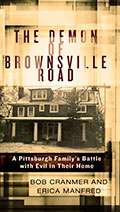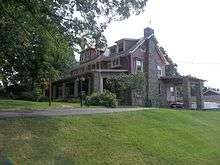The Demon of Brownsville Road
 The first edition of the book | |
| Author | Bob Cranmer/Erica Manfred |
|---|---|
| Country | United States |
| Language | English |
| Genre | Horror novel |
| Publisher | Berkley Books of Penguin Random House |
Publication date | August 5, 2014 |
| Media type | Print, electronic, audio |
The Demon of Brownsville Road is a book by Bob Cranmer and Erica Manfred, published in August 2014. The story is also the basis of a series of television documentaries and dramatizations released between 2011 and 2016. The book is claimed to be based on the paranormal experiences of the Cranmer family, with Bob Cranmer telling the first-person account.[1]
Historical basis
In March of 1792 a mother and her three children were killed by marauding Native Americans in the vicinity of Fort Pitt during the Northwest Indian War. The book claims that this massacre occurred on the ground on which the house is built and that the four individuals are buried in the front yard. The book also maintains that a local doctor performed hundreds of illegal abortions in the house during the early decades of the Twentieth Century. There are no records or firsthand accounts of this but an investigative newspaper article did identify that such a doctor did exist and that local lore supported the claim that he performed abortions, In December 1988, Bob and Lesa Cranmer and their four children moved into the house. This began the long string of events that eventually led to a “demonic entity” being expelled from the house in 2006 by priests of the Catholic Church. [2][3]
The Book
- This section is based on the version of events in Bob Cranmer's (and Erica Manfred) 2014 book The Demon of Brownsville Road.
The house at 3406 Brownsville Road was built in 1909-10 and had three previous owners prior to the Cranmer’s. In December 1988 Bob and Lesa Cranmer bought the house upon Bob being transferred to Pittsburgh by his employer. Bob states that the house was his “dream” to own, and that it mysteriously went up for sale the same week that they began looking for a house to buy. As a young child he would often stand and stare at the house hoping that someday he could see the inside. The three-story house was built in the Craftsman style and would later be designated as a historical landmark (by Pittsburgh History & Landmarks) because of its unique design. Bob and Lesa married in 1980 while Bob was an officer in the U.S. Army. He left the service in 1986 and went to work for AT&T in Whippany, New Jersey. Their objective was to relocate to Pittsburgh, where Bob had grown up. This was unexpectedly realized quicker than they had expected as they had just built a new house in 1987. They had four children: Jessica (4), Bobby (3), David (2), and Charles (2 months) when they moved to Pittsburgh.
Bob Cranmer states that the sellers seemed very anxious to move out and surprisingly accepted his first (low-ball) offer without any negotiations. During a walk-through of the house young Bobby Jr. wondered off by himself as the group went to the basement. He would soon be found on the front staircase crying and hyperventilating as if “he’d seen a ghost”. Lesa later expressed to Bob her misgivings about the house, that it was much too large, and furthermore “gave her the creeps.” Bob discounted this and was determined to make this house a home for his young family. He did however ask the seller if there “was anything wrong with the house.” Understanding exactly what he was referring to the seller assured him that the house was fine and that Catholic Mass was conducted several times in the living room of the house. Bob took this as an odd response but took it with the reassurance that had been implied. Later the next Spring Bob discovered a small metal box buried in the front yard containing Catholic religious items. He called the previous owner who had assured him that “the house was fine” only now to hear him say “just put it back where you found it.”
Within weeks of moving into the house Bob and Lesa began to experience paranormal activity in the house. The first phenomenon they experienced was a pull-chain on a light in a coat closet that continuously wrapped itself around the light and would never remain in the hanging position. Soon other nuisance activities would soon begin and continue for years, the family choosing to ignore them, accepting that they shared their home with a “spirit”. Bob would go on to hold political office in the 1990’s, first as a councilman and then county commissioner, gaining significant notoriety and celebrity in the western Pennsylvania (Pittsburgh) area.
Over the years the Cranmer family became increasingly dysfunctional and eventually Lesa and two of the children would experience serious mental issues which would require hospitalization. Bob had no idea that the spirit in the house had anything to do with the relational and psychological issues within his family and he attempted to manage his way through it. However, one night in 2003 his oldest son attacked him and Bob would be arrested. The next morning his elderly aunt who was living with the family was also found dead in her bed from natural causes.
All charges associated with the incident would eventually be dropped but the paranormal activity in the house increased like a dam had been broken. Within a month Bob was at his wits end and decided to contact the Catholic Church for help (the Cranmer’s were not Catholics at the time.) The mayor of Pittsburgh, Tom Murphy, who was a personal friend of Cranmer, went to see the then Bishop of Pittsburgh, Donald Wuerl, to request the assistance of the Diocese. Wuerl would assign management of the case to Father Ron Lenguin who would eventually be assisted by several other priests and one lay person, Connie Valenti. Thus would begin a battle to cleanse the house from a demonic spirit that would take two years. Paranormal researchers from Penn State University would eventually become associated with the situation and would later move on to celebrity with a hit television show called Paranormal State.[4]
The infestation of the house would come to an end in February 2006 and Cranmer would begin to write the story from notes that he had kept the next year. The book was released in 2014 with great media acclaim and Cranmer would be interviewed across the country. His reputation as a public official, combined with the involvement of other notable individuals; i.e. Mayor Thomas J. Murphy, Jr., Bishop Donald Wuerl, and Fr. Ronald Lenguin, added a foundation of credibility to the story while also attracting the attention of the Pittsburgh media. Cranmer had little to gain and his reputation to lose, yet he states that the story had to be told to verify that “Evil” does exist in the world.
The manuscript was written by Cranmer and eventually reduced in size and rearranged by the professional author and editor Erica Manfred. This was the third of three writers employed by Cranmer as issues and conflicts kept arising which seemed intent on preventing the book from being published. The difficulties were so intense that Cranmer became convinced that Evil itself was fighting to keep the story from being told.
Criticism
With the notoriety of the book in the metropolitan Pittsburgh area, one of the two major newspapers (The Post-Gazette) decided to do an investigative article about the story. Many of the individuals in the book were interviewed and some of the historical accounts were checked. The doctor cited was verified to have been a local resident, as was his nefarious abortionist reputation, obviously with no official records existing for decades-old illegal activities. The primary source of criticism came from the children and grandchildren of the two families who preceded the Cranmer’s living in the house. (A period of 47 years, all previous owners being deceased.) They all claimed to have no recollection of any paranormal activity in the house and that the story was fabricated by Cranmer for his own waning notoriety.
However Cranmer states in the book that one daughter (Barbara Wagner) who grew up in the house did detail significant activity to him while he was writing the book (she died before publication). In addition he claims that one of the sons of the previous owners (the Joyce's) also verified strange activity to him before he knew that a book would cast an unfavorable light on his deceased father.[5] Cranmer has offered to pay for and take a lie-detector test concerning any of the claims presented in his book as long as the three adult children of the previous owners join him.

Cranmer's response to the article, which was printed by the Post-Gazette 3 days later, is as follows:
October 29, 2014 12:00 AM
Any author should relish an article about their book by a major newspaper, positive or negative. However, the recent PG coverage of my book was over the top (“Former Residents of Brentwood ‘Demon’ House Dispute Book,” Oct. 26). The front-page Sunday article clearly sought to discredit the story, its basis in Christian faith and its controversial topics.
I’ve dealt with the press enough to know that when an article is to have a slant nothing one says can change it. I spent almost two hours on the phone with the reporter, successfully addressing every objection, yet only a few brief comments from me were published. Once I determined that the reporter’s intent was negative, I simply braced myself. But if it prompts more reading of the book so much the better.
Television
The Demon of Brownsville Road has been the subject of a series of programs which are dramatizations:
- The Exorcist Files, The Discovery Channel (2011)
- Paranormal Witness, True Terror - The Molech, SyFy (2014)
- A Haunting, Demon's Lair, TLC (2016)
It was announced in 2015 that the Fox Network bought the rights to the story for one year and that a new series based on the book was to be aired in 2016. However after the pilot episode was written Fox decided to cancel the project and move forward with another program[6]
External links
- The Demon of Brownsville Road – website created by Bob Cranmer; contains book excepts and media interviews.
- Paranormal Witness.
- Life after paranormals.
- The Exorcist Files.
- A Haunting - A Demon's Lair.
References
- ↑ http://www.demonofbrownsville.com.asp
- ↑ "Evidence gives support to tales of local history in South Hills area". Pittsburgh Tribune Review. Retrieved March 6, 2013.
- ↑ "Former residents of Brentwood 'demon' house dispute book's claims". Pittsburgh Post-Gazette. Retrieved October 26, 2014.
- ↑ "Paranormal State's Ryan Buell: My Top 3 Spookiest Encounters=People Magazine". Retrieved October 21, 2010.
- ↑ "Former residents of Brentwood 'demon' house dispute book's claims". Pittsburgh Post-Gazette. Retrieved October 26, 2014.
- ↑ "Fox Plots Demon Drama 'Haunted' 'Fast & Furious' Duo". The Hollywood Reporter. Retrieved November 19, 2015.